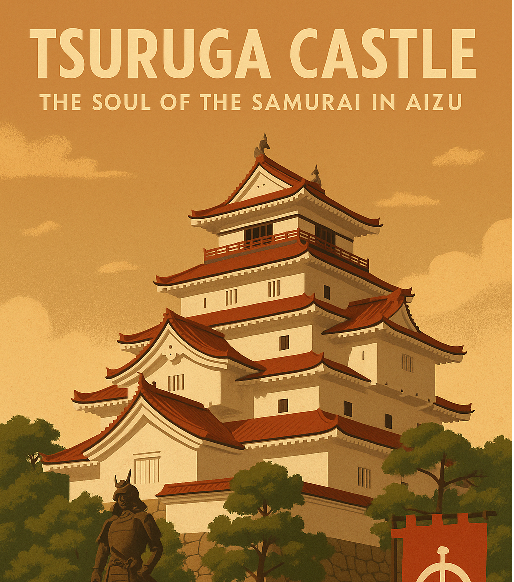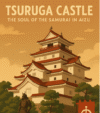
In the northern region of Japan’s Honshu island, the city of Aizuwakamatsu is home to one of the country’s most resilient and emotionally stirring castles: Tsuruga Castle, also known as Aizuwakamatsu Castle. With its iconic red-tiled roofs and a deep connection to Japan’s samurai heritage, this historical stronghold is a powerful symbol of loyalty, courage, and perseverance.
Originally built in the 14th century and reconstructed multiple times, the current Tsuruga Castle is a faithful restoration completed in 1965, with a red-tile makeover in 2011 to match the castle’s appearance during the late Edo period.
A Fortress of Loyalty – The Spirit of the Boshin War
Tsuruga Castle played a pivotal role during the Boshin War (1868–1869), a civil conflict between the Tokugawa shogunate and the forces of the new imperial government. As the last stronghold of resistance in the north, Aizu endured a month-long siege. During this time, a tragic episode unfolded: a group of teenage samurai known as the Byakkotai (White Tiger Corps) mistakenly believed the castle had fallen and took their own lives on nearby Mount Iimori. Their story lives on as a symbol of loyalty and youthful sacrifice.
Walking through the castle grounds and museum today, visitors can feel the lingering presence of these historical moments. Exhibits in English highlight the castle’s military significance, samurai culture, and the unyielding spirit of Aizu.
Where the Way of the Warrior Lives On
Even today, the bushidō (way of the warrior) lives on in Aizu. The locals take pride in their heritage, and martial arts such as kenjutsu and iaidō are still practiced in the region. The atmosphere is respectful and dignified—reflecting the legacy of a warrior culture that valued honor above all.
After the Castle: Food & Local Crafts
No visit to Tsuruga Castle is complete without enjoying the tastes and traditions of the region.
🍴 Must-Try Food:
- Sauce Katsudon: A specialty of Aizu—deep-fried pork cutlet served over rice and topped with savory-sweet sauce.
- Aizu Soba: Buckwheat noodles grown in the highlands, often served with seasonal mountain vegetables.
- Kitakata Ramen: If you have time, take a short trip to neighboring Kitakata, famous for its rich soy sauce-based ramen and chewy, flat noodles.
🎁 Recommended Souvenirs:
- Aizu Lacquerware (Aizu-nuri): Elegant and durable handcrafted lacquerware, a tradition dating back centuries.
- Byakkotai-themed items: Thoughtful gifts that connect visitors to the historical heart of Aizu.
- Local Sake: Aizu is known for high-quality sake made with pure mountain water and local rice.
Final Thoughts
Tsuruga Castle is more than a photogenic fortress—it is the spiritual heart of a proud and disciplined people. Whether you’re drawn by the dramatic history of the Boshin War, the grace of samurai tradition, or the culinary delights of the region, a visit to Aizu offers a rare window into the enduring soul of Japan.
鶴ヶ城:会津に生きる武士の魂
日本本州の北部地域にある会津若松市は、日本で最もたくましく、感情を揺さぶる城の一つである鶴ヶ城(またの名を会津若松城)の所在地です。赤い瓦屋根で知られるその姿と、日本の武士遺産との深い結びつきによって、この歴史的な要塞は忠義、勇気、忍耐の強力な象徴となっています。
もともとは14世紀に建てられ、何度も再建されたこの鶴ヶ城は、1965年に忠実に復元され、2011年には江戸時代後期の外観に合わせて赤瓦に葺き替えられました。
忠義の要塞 ― 戊辰戦争の精神
鶴ヶ城は、戊辰戦争(1868〜1869年)中に重要な役割を果たしました。これは、徳川幕府と新政府軍との間で起こった内戦です。北の最後の抵抗拠点として、会津は1か月にわたる包囲戦に耐えました。この期間中に、悲劇的な出来事が起こりました。白虎隊と呼ばれる10代の若い武士たちの一団が、城がすでに落城したと誤って信じ、近くの飯盛山で自決したのです。彼らの物語は、忠誠と若き犠牲の象徴として今も語り継がれています。
今日、城の敷地や博物館を歩くと、こうした歴史の記憶が今なお感じられます。英語の展示が、城の軍事的な重要性、武士文化、そして会津の不屈の精神を紹介しています。
武道のこころが今も息づく場所
今日においても、**武士道(ぶしどう)**は会津に息づいています。地元の人々はその遺産を誇りに思っており、剣術や居合道といった武道がこの地域で今も実践されています。その雰囲気は厳かで品があり、何よりも名誉を重んじた武士の文化の遺産を映し出しています。
城のあとに:食と伝統工芸
鶴ヶ城を訪れたら、地元の味と伝統に触れずにはいられません。
🍴 絶対に食べたい料理:
- ソースカツ丼:会津の名物。揚げた豚カツをごはんの上にのせ、甘辛いソースをかけた料理。
- 会津そば:高地で育ったそばを使い、季節の山菜と一緒に提供されることが多いです。
- 喜多方ラーメン:時間があれば、隣町の喜多方まで足を延ばしてみましょう。濃い醤油味と平打ち麺が特徴です。
🎁 おすすめのお土産:
- 会津塗(あいづぬり):何世紀もの歴史を持つ、エレガントで耐久性のある手作り漆器。
- 白虎隊グッズ:会津の歴史と心に触れられる、思いのこもったお土産です。
- 地酒:清らかな山の水と地元の米から作られた、上質な会津の日本酒も人気です。
終わりに
鶴ヶ城は、単なる写真映えする要塞ではありません。それは、誇り高く、節度ある人々の精神的な中心でもあります。戊辰戦争のドラマチックな歴史に惹かれる人も、武士の伝統の美しさに魅せられる人も、あるいは地域の美味を楽しみたい人も、会津への旅は日本の魂が今も生きている場所へとあなたを導いてくれるでしょう。
